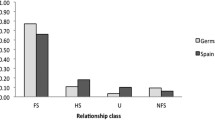Abstract
We used multi-locus DNA fingerprinting to characterise the genetic mating system of the socially monogamous yellow warbler (Dendroica petechia). Over 2 years there were no instances of brood parasitism, but 59% of families (n = 90) contained extrapair sired young and 37% of offspring (n = 355) were of extra-pair paternity. Most hypotheses for extra-pair mating in monogamous species assume a paternity benefit to extra-pair sires, and focus on the benefit(s) to females. However, the assumption of male benefit has been little tested. Among yellow warblers, known extra-pair sires were just as likely to be cuckolded as any male in the population, and there was at least one reciprocal exchange of extra-pair paternity. Nevertheless, among known extra-pair sires, the paternity gains from extra-pair paternity were, on average, greater than the losses in their own families. These results show there is a paternity benefit to certain males. However, the benefit is not absolute but relative and therefore more difficult to measure. The results also suggest that patterns of extra-pair fertilisation are not determined by female choice alone. Most confirmed extra-pair mates were territorial neighbours, but some resided as far as three territories apart, and greater spatial separation was implied in other cases. Thus, the opportunity for extra-pair mating is great. We estimate that as a result of extra-pair fertilisations, variance in male mating success is increased somewhere between 3-fold and 15-fold over that which would result from within-pair reproduction alone. These findings affirm the potential importance of extra-pair reproduction for sexual selection in monogamous species and they support earlier suggestions that extra-territorial forays by male yellow warblers are for the purpose of extra-pair mating.
Similar content being viewed by others
References
Amos W, Barrett JA, Pemberton JM (1992) DNA fingerprinting: parentage studies in natural populations and the importance of linkage analysis. Proc R Soc Lond B 249:157–162
Andersson M (1994) Sexual selection. Princeton University Press, Princeton
Arnold SJ, Wade MJ (1984) On the measurement of natural and sexual selection: theory. Evolution 38:709–719
Birkhead T, Moller AP (1993) Female control of paternity. Trends Ecol Evol 8:100–104
Birkhead TR, Burke T, Zann R, Hunter FM, Krupa AP (1990) Extra-pair paternity and intraspecific brood parasitism in wild zebra finches Taeniopygia gutta, revealed by DNA finger-printing. Behav Ecol Sociobiol 27:315–324
Birkhead TR, Moller AP (1992) Sperm competition in birds: evolutionary causes and consequences. Academic Press, London
Brookfield JF, Carter RE, Mair GC, Skibinski DOF (1993) A case study of the interpretation of linkage data using DNA fingerprinting probes. Mol Ecol 2:209–218
Bruford MW, Hanotte O, Brookfield JFY, Burke T (1992) Single-locus and multi-locus DNA fingerprinting. In: Hoelzel R (ed) Molecular genetic analysis of populations: a practical approach. IRL, Oxford, pp 225–269
Burke T, Bruford MW (1987) DNA fingerprinting in birds. Nature 327:149–152
Darwin C (1871) The descent of man, and selection in relation to sex. John Murray, London
DellaSalla DA (1986) Polygyny in the yellow warbler. Wilson Bull 98:152–155
Dunn PO, Robertson RJ, Michaud-Freeman D, Boag PT (1994) Extra-pair paternity in tree swallows: why do females mate with more than one male? Behav Ecol Sociobiol 35:273–281
Fisher R (1930) Genetical theory of natural selection. Clarendon Press, Oxford
Ford N (1983) Variations in mate fidelity in monogamous birds. In: Power DM (ed) Current ornithology. Plenum, New York, pp 329–356
Gowaty PA (1985) Multiple parentage and apparent monogamy in birds. Ornithol Monogr 37:11–21
Gyllensten UB, Jakobsson S, Temrin H (1990) No evidence for illegitimateyoung in monogamous and polygynous warblers. Nature 343:168–170
Hamilton WD (1990) Mate choice near or far. Am Zool 30: 341–352
Hébert PN (1993) An experimental study of brood reduction and hatching asynchrony in yellow warblers. Condor 95:362–371
Hill GE (1990) Female house finches prefer colourful males: sexual selection for a condition-dependent trait. Anim Behav 40:563–572
Hill GE (1991) Plumage coloration is a sexually selected indicator of male quality. Nature 350:337–339
Hill GE, Montgomerie R, Roeder C, Boag P (1994) Sexual selection and cuckoldry in a monogamous songbird: implications for sexual selection theory. Behav Ecol Sociobiol 35:193–199
Hobson KA, Sealy SG (1989) Mate guarding in the yellow warbler Dendroica petechia. Ornis Scand 20:241–249
Hoysak DJ, Weatherhead PJ (1991) Sampling blood from birds: a technique and an assessment of its effect. Condor 93:746–752
Hunter FM, Burke T, Watts SE (1992) Frequent copulation as a method of paternity assurance in the northern fulmar. Anim Behav 44:149–156
Hunter FM, Petrie M, Otronen M, Birkhead T, Moller AP (1993) Why do females copulate repeatedly with one male? Trends Ecol Evol 8:21–26
Jeffreys AJ, Wilson V, Them SL (1985) Hypervariable “minisatellite” regions in human DNA. Nature 314:67–73
Kempenaers B, Dhondt AA (1993) Why do females engage in extra-pair copulations? a review of hypotheses and their predictions. Belg J Zool 123:93–103
Kempenaers B, Verheyen GR, Van den Broeck M, Dhondt AA (1992) Extra-pair paternity results from female preference for high-quality males in the blue tit. Nature 357:494–496
Kirkpatrick M, Price T, Arnold SJ (1990) The Darwin-Fisher theory of sexual selection in monogamous birds. Evolution 44:180–193
Lack D (1968) Ecological adaptations for breeding in birds. Chapman and Hall, London
Lifjeld IT, Dunn PO, Robertson RJ, Boag PT (1993) Extra-pair paternity in monogamous tree swallows. Anim Behav 45:213–229
Lorenz FW (1966) Behavior of spermatozoa in the oviduct in relation to fertility. In: Horton-Smith C, Amorose EC (ed) Physiology of the domestic fowl. Oliver and Boyd, Edinburgh
McKitrick MC (1990) Genetic evidence for multiple parentage in eastern kingbirds (Tyrannus tyrannus). Behav Ecol Sociobiol 26:149–155
Moore FR, McDonald MV (1993) On the possibility that intercontinental landbird migrants copulate enroute. Auk 110:157–160
Morton ES, Forman L, Braun M (1990) Extrapair fertilizations and the evolution of colonial breeding in purple martins. Auk 107:275–283
Mulder RA, Dunn PO, Cockburn A, Lazenby-Cohen KA, Howell MJ (1994) Helpers liberate female fairy-wrens from constraints on extra-pair mate choice. Proc R Soc Lond B 255:223–229
Møller A (1986) Mating systems among European passerines: a review. Ibis 128:234–250
Queller DC, Strassmann JE, Hughes CR (1993) Microsatellites and kinship. Trends Ecol Evol 8:285–288
Reid ML, Sealy SG (1986) Behavior of a polygynous yearling yellow warbler. Wilson Bull 98:315–317
Sealy SG (1984) Extra-pair copulation in the yellow warbler (Dendroica petechia). Anim Behav 32:295–296
Selander RK (1972) Sexual selection and dimorphism in birds. In: Campbell BG (ed) Sexual selection and the descent of man, 1871–1971. Aldine, Chicago, pp 200–222
Seutin G, White BN, Boag PT (1991) Preservation of avian blood and tisue samples for DNA analyses. Can J Zool 69:82–90
Shin HS, Bargiello TA, Clark BT, Jackson FR, Young MW (1985) An unusual coding sequence from a Drosophila clock gene is conserved in vertebrates. Nature 317:445–448
Smith JMN, Arcese P (1989) How fit are floaters? Consequences of alternative territorial behaviors in a nonmigratory sparrow. Am Nat 133:830–845
Smith SM (1988) Extra-pair copulations in black-capped chickadees: the role of the female. Behaviour 107:15–23
Trivers RL (1972) Parental investment and sexual selection. In: Campbell BG (ed) Sexual selection and the descent of man, 1871–1971. Aldine, Chicago, pp 136–179
Wade MJ (1979) Sexual selection and variance in reproductive success. Am Nat 114:742–764
Wade MJ (1987) Measuring sexual selection. In: Bradbury JW, Andersson MB (eds) Sexual selection: testing the alternatives Wiley, Chichester, pp 197–207
Wade MJ, Arnold SJ (1980) The intensity of sexual selection in relation to male sexual behaviour, female choice, and sperm precedence. Anim Behav 28:446–461
Westneat DF (1987) Extra-pair fertilizations in a predominantly monogamous bird: genetic evidence. Anim Behav 35:877–886
Westneat DF (1990) Genetic parentage in the indigo bunting: a study using DNA fingerprinting. Behav Ecol Sociobiol 27:67–76
Westneat DF (1993) Polygyny and extra-pair fertilizations in eastern red-winged blackbirds (Ageliaus phoeniceus). Behav Ecol 4:49–60
Westneat DF, Noon WA, Reeve HK, Aquadro CF (1989) Improved hybridization conditions for DNA “fingerprints” probed with M13. Nucleic Acids Res 16:4161
Westneat DF, Sherman PW, Morton ML (1990) The ecology and evolution of extra-pair copulations in birds. In: Power DM (ed) Current ornithology. Plenum, New York, pp 331–362
Wetton J, Carter RE, Parkin DT, Walters D (1987) Demographic study of a wild house sparrow population by DNA fingerprinting. Nature 327:147–149
Zar JH (1984) Biostatistical analysis. Prentice Hall, Englewood Cliffs
Author information
Authors and Affiliations
Additional information
Communicated by M. Zuk
Rights and permissions
About this article
Cite this article
Yezerinac, S.M., Weatherhead, P.J. & Boag, P.T. Extra-pair paternity and the opportunity for sexual selection in a socially monogamous bird (Dendroica petechia). Behav Ecol Sociobiol 37, 179–188 (1995). https://doi.org/10.1007/BF00176715
Received:
Accepted:
Issue Date:
DOI: https://doi.org/10.1007/BF00176715




